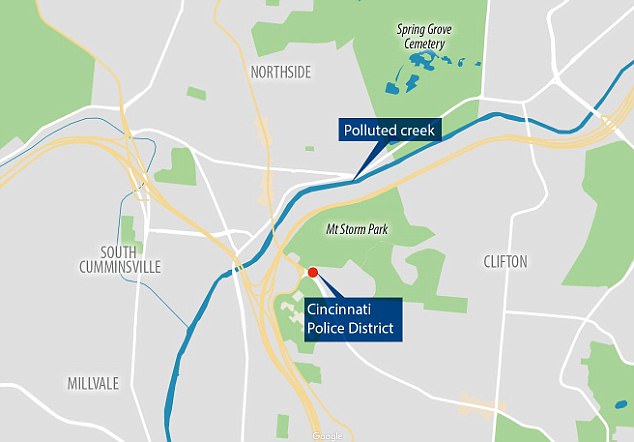 A cancer cluster is suspected after the deaths of six police officers in the District 5 unit of the Cincinnati, Ohio Police Department over the course of two years.
A cancer cluster is suspected after the deaths of six police officers in the District 5 unit of the Cincinnati, Ohio Police Department over the course of two years.
All of the officers were under the age of 60, and all of them spent a significant portion of their days working in the office of Cincinnati’s fifth district.
Although the police department has not released names, police union president Dan Hils told FOX19 on Tuesday that there are more officers that have survived cancer in the unit as well.
The District 5 police station sits just on the other side of Interstate-75 from Mill Creek, which was declared ‘the most endangered urban river in North America’ by American Rivers in 1997.
Speaking at a press conference on Tuesday, Hils said ‘those six people all lived very clean lives and were still young,’ CNN reported.
Hils pleaded the city’s mayor and city council members to arrange for the building to be shut down, and the District 5 police officers transferred elsewhere.
He requested that the relocation be complete by Christmas, and for there to be a plan of action in place by the end of October.
Hils said at the press conference that when the station was built it was supposed to be a ‘temporary fix,’ and the policemen were long told that they needed to be moved to another building.
Investigating cancer clusters
According to the National Institute of Cancer, there are essentially four steps in the investigation of a cancer clusters.
First, information has to be gathered on the number and types of cancer cases, the people diagnosed, and potential environmental concerns.
This information is then compared to data on cancer and those affected by it in the state.
If that comparison shows that there is a statistically significant difference in cancer rates in the suspected cluster and the rest of the state, it may be possible and necessary to do an epidemiological study.
In many cases, a study isn’t possible, especially if there aren’t enough cases. Even if it is, determining if there is an environmental cause can take years.
Meanwhile, city council member Charlie Winburn asked for the District 5 officers to be transferred within 30 days.

Suspected cancer cluster in Cincinnati police unit just feet away from a ‘toxic creek’ has killed 6 officers under the age of 60
Six officers that worked in Cincinnati Police Department District 5 died of cancer between 2015 and 2016
There are reportedly other officers in the unit living with cancer
A city councilman has called for all District 5 officers to be transferred in 30 days
By Natalie Rahhal For Dailymail.com
Published: 12:58 EDT, 27 September 2017 | Updated: 17:10 EDT, 27 September 2017
e-mail
46
shares
31
View comments
A cancer cluster is suspected after the deaths of six police officers in the District 5 unit of the Cincinnati, Ohio Police Department over the course of two years.
All of the officers were under the age of 60, and all of them spent a significant portion of their days working in the office of Cincinnati’s fifth district.
Although the police department has not released names, police union president Dan Hils told FOX19 on Tuesday that there are more officers that have survived cancer in the unit as well.
The District 5 police station sits just on the other side of Interstate-75 from Mill Creek, which was declared ‘the most endangered urban river in North America’ by American Rivers in 1997.
+1
The Cincinnati Police Department District 5 station, where 6 cops have been killed by cancer in the last two years, sits dangerously close to Mill Creek, once named ‘the most endangered urban river in North America’ by American Rivers
Read more: http://www.dailymail.co.uk/health/article-4926112/Suspected-cancer-cluster-Cincinnati-police-unit.html#ixzz4txKWcHUJ
Follow us: @MailOnline on Twitter | DailyMail on Facebook
The Cincinnati police department in a statement said that the concern over the cancer cluster is a ‘top priority’ and that its staff is ‘in the process of assessing temporary locations on a leased basis and are working toward a long term solution as well.’
The District 5 building, located at 1012 Ludlow Avenue, is near the historically polluted Mill Creek.
Though there have been efforts to clean up the creek in recent years, its banks were once home to soap and beauty product factories, pork packaging factories and General Electric, at the height of Cincinnati’s manufacturing boom in the 19th and 20th Centuries.
The factories are gone but the waste they contributed to the creek could still be endangering the District 5 police officers.
According to the National Cancer Institute (NCI), a cancer cluster is any area where the incidence of cancer is higher than expected.
It warns that even if a cluster is confirmed, it may not be linked to any one cause, or may even be pure coincidence.
The NCI also reports that about 171 per every 100,000 die each year from cancer. Six police officers out the 129 working in District 5 have died in two years.
That puts the annual cancer death rate in the unit at nearly 14 times the national average.
As he heard more and more about cancer deaths from his colleagues Hils said in the press conference that ‘without a PhD… just common sense,’ he became concerned for the health of District 5 police officers.
Written by Natalie Rahhal and published by The Daily Mail ~ September 27, 2017.
 FAIR USE NOTICE: This site contains copyrighted material the use of which has not always been specifically authorized by the copyright owner. We are making such material available in our efforts to advance understanding of environmental, political, human rights, economic, democracy, scientific, and social justice issues, etc. We believe this constitutes a ‘fair use’ of any such copyrighted material as provided for in section 107 of the US Copyright Law. In accordance with Title 17 U. S. C. Section 107, the material on this site is distributed without profit to those who have expressed a prior interest in receiving the included information for research and educational purposes. For more information go to: http://www.law.cornell.edu/uscode/17/107.shtml“
FAIR USE NOTICE: This site contains copyrighted material the use of which has not always been specifically authorized by the copyright owner. We are making such material available in our efforts to advance understanding of environmental, political, human rights, economic, democracy, scientific, and social justice issues, etc. We believe this constitutes a ‘fair use’ of any such copyrighted material as provided for in section 107 of the US Copyright Law. In accordance with Title 17 U. S. C. Section 107, the material on this site is distributed without profit to those who have expressed a prior interest in receiving the included information for research and educational purposes. For more information go to: http://www.law.cornell.edu/uscode/17/107.shtml“
